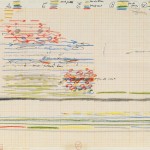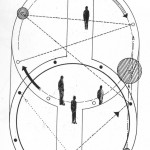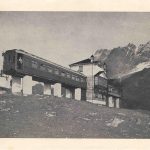Polish-Russian artist Kasimir Malevich is mostly known for his paintings that accompanied the artist’s evolution from abstract art to suprematism.
From 1923 to the early 1930s, Malevich also produced several three-dimensional models, assemblages of abstract forms which appear similar to models of skyscrapers, called “arkhitektons“. The drawings accompaining the construction of the models are called “planits“.
In a series of prismatic, quasi architectural sculptures (which he called ‘Arkhitektons’) (Malevich, n) sought to demonstrate the timeless laws of architecture underlying the ever changing demands of function. (…)
(caption beside a photograph of an Arkhitekton, 1924): Malevich’s Arkhitektons resemble early De Stijl compositions in which ornament is non-figural and ‘form’ and ‘ornament’ are differentiated only by scale. These studies are purely experimental and the buildings have no function and no internal organization.
Alan Colquhoun: Modern Architecture (Oxford University Press – 2002).
The arkhitektons are mostly white plaster models made up by several rectangular blocks added one another. Usually a central bigger block is the main compositional element and smaller parallelepipeds are progressively added to it. No function is shown or translated into form, the final shape being the pure result of assembling abstract masses in vertical or horizontal. With their spatialization of abstraction and their formal non-objectivity, the arkhitektons embody Malevich effort to translate the suprematist principles of composition to three-dimensional forms and architecture.
Suprematism has two methods of revealing the elements of perception: the “spatial” method and the “easel” method: space and canvas are the places where they appear…
The problem of form has played and still plays an immense part in Suprematist art. Without it, it is impossible to reveal any of the elements of perception: color, dynamic, static, mechanical, motive, etc.
It can thus be seen that the first essential is to create one objective element of form, with the help of which one can express perceptions by changing the relation of one to another.Kazimir Malevich, Painting and the Problem of Architecture,
(in: Nova generatsiia Vol. 3, №. 2 (1928) – full text on The Charnel-House)


















Related:
Exhibition “Malevitch” at the Centre Pompidou (Pontus Hulten and Jean-Hubert Martin. 1978): Presentation 1, Presentation 2, poster, review, video.
Maria Gough “The Artist as Producer. Russian Constructivism in Revolution”
All images via The Charnel-House





[…] Alpha (Alpha Architecton), 1923, © State Russian Museum, St Petersburg [Source: http://socks-studio.com/2015/07/15/kazimir-malevichs-arkhitektons, [accessed […]